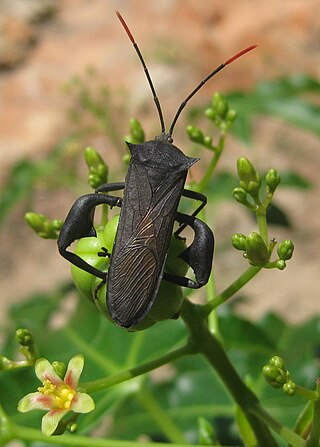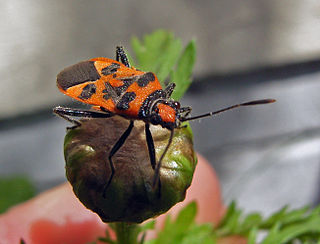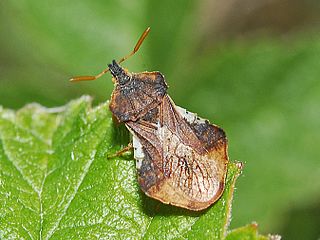
Pentatomidae is a family of insects belonging to the order Hemiptera, generally called shield bugs or stink bugs. Pentatomidae is the largest family in the superfamily Pentatomoidea, and contains around 900 genera and over 4700 species. As hemipterans, the pentatomids have piercing sucking mouthparts, and most are phytophagous, including several species which are severe pests on agricultural crops. However, some species, particularly in the subfamily Asopinae, are predatory and may be considered beneficial.

Pyrrhocoridae is a family of insects with more than 300 species world-wide. Many are red coloured and are known as red bugs and some species are called cotton stainers because their feeding activities leave an indelible yellow-brownish stain on cotton crops. A common species in parts of Europe is the firebug, and its genus name Pyrrhocoris and the family name are derived from the Greek roots for fire "pyrrho-" and bug "coris". Members of this family are often confused with, but can be quickly separated from, Lygaeidae by the lack of ocelli on the top of the head.

Coreidae is a large family of predominantly sap-sucking insects in the Hemipteran suborder Heteroptera. The name "Coreidae" derives from the genus Coreus, which derives from the Ancient Greek κόρις (kóris) meaning bedbug.

Coreoidea is a superfamily of true bugs in the infraorder Pentatomomorpha which includes leaf-footed bugs and allies. There are more than 3,300 described species in Coreoidea.

The Lygaeoidea are a sizeable superfamily of true bugs, containing seed bugs and allies, in the order Hemiptera. There are about 16 families and more than 4,600 described species in Lygaeoidea, found worldwide. Most feed on seeds or sap, but a few are predators.

Alydidae, commonly known as broad-headed bugs, is a family of true bugs very similar to the closely related Coreidae. There are at least 60 genera and 300 species altogether. Distributed in the temperate and warmer regions of the Earth, most are tropical and subtropical animals; for example Europe has a mere 10 species, and only 2 of these occur outside the Mediterranean region.

Coreinae is a subfamily in the hemipteran family Coreidae. They have been shown to be paraphyletic with respect to Meropachyinae.

The Harpactorinae are a large subfamily of the Reduviidae. About 300 genera and 2,000 species worldwide have been described. Some of the species of the genera Zelus, Pselliopus, Sinea, and Apiomerus are of interest as biological pest control agents.

Harpactorini is a tribe of the Harpactorinae. This group is the most diverse of the entire assassin bug family, with 51 genera recognized in the Neotropical Region and 289 genera and 2003 species overall.

Phymata crassipes is a species of assassin and thread-legged bugs belonging to the family Reduviidae, subfamily Phymatinae.

Corizus hyoscyami is a species of scentless plant bug belonging to the family Rhopalidae, subfamily Rhopalinae. It is commonly called the cinnamon bug or black and red squash bug.

Liorhyssus hyalinus is a species of scentless plant bugs belonging to the family Rhopalidae, subfamily Rhopalinae.

Stictopleurus subtomentosus is a species of scentless plant bugs belonging to the family Rhopalidae, subfamily Rhopalinae.

Stictopleurus is a genus of scentless plant bugs belonging to the family Rhopalidae, subfamily Rhopalinae.

Dinidoridae is a small family of hemipteran "true bugs" comprising about sixteen genera and a hundred species the Hemiptera suborder Heteroptera. As a group the family does not have any common name. Until the late 19th century they were generally regarded as a subfamily of Pentatomidae.

Rhopalinae is a subfamily of scentless plant bugs in the family Rhopalidae. There are at least 20 genera and more than 170 described species in Rhopalinae.

Stictopleurus crassicornis is a species of scentless plant bugs belonging to the family Rhopalidae, subfamily Rhopalinae.

Alydus calcaratus is a bug species with a Holarctic distribution ranging from the British Isles almost all over Europe to eastern Siberia and China. Moreover, the species also in northern North America from Alaska and Québec across the United States to Wyoming. It is the only species in the family in northern Central Europe outside of the Alps.
Cercotmetus is a genus of water bugs in the subfamily Ranatrinae. The recorded distribution of this genus is from is from mainland Asia to New Guinea and northern Australia.

The Homoeocerini are a tribe of leaf-footed bugs, in the subfamily Coreinae erected by Amyot and Serville in 1843. Genera are distributed from Africa to South-East Asia.


















